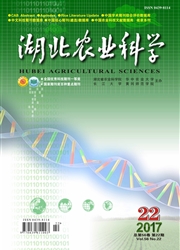

 中文摘要:
中文摘要:
以转基因的抗晚疫病型马铃薯(Solanum tuberosum)株系DR1、DR3a和野生型株系DG为材料,通过半定量RT-PCR研究了接种晚疫病病原菌(Phytophthora infestans)生理小种89148-9后叶片中水杨酸和乙烯合成途径关键酶苯丙氨酸解胺酶(PAL)基因(poPAL)和1-氨基环丙烷-1-羧酸(1-Aminocyclopropane-1-carboxylic acid,ACC)合成酶(ACS)基因(poACS)的表达情况。结果表明,接种后3个株系都能诱导poPAL和poACS基因的表达,但大部分转基因株系叶片内该基因的诱导表达量高于野生型,并且其表达峰值多数早于野生型。说明poPAL和poACS基因可能参与了马铃薯的抗晚疫病反应,但不同株系中这些基因的诱导表达模式不同,这可能是不同马铃薯株系抗、感晚疫病的原因所在。
 英文摘要:
英文摘要:
Phenylalanine ammonia-lyase(PAL) and 1-aminocyclopropane-1-carboxylic acid(ACC) synthase(ACS) are the key enzymes in the biosynthesis pathway of salicylic acid and ethylene respectively.Expression patterns of gene encoding these key enzymes(poPAL and poACS) in potato(Solanum tuberosum) were investigated by semi-quantitative RT-PCR after injection of Phytophthora infestans physiological strain 89148-9 to potato transgenic resistant strains DR1,DR3a and wild susceptive line DG.The results showed that expression of poPAL and poACS genes was increased in leaves of the three potato lines after inoculation of P.infestans.The expression level in transgenic lines was mostly higher than that in wild line and the peak value in transgenic lines generally appeared earlier to that in wild line.The results suggested that poPAL and poACS were related with the resistance to late blight in potato;but the expression models were different between transgenic lines and wild line,which might be responsible for resistance or susceptibility to P.infestans.
 同期刊论文项目
同期刊论文项目
 同项目期刊论文
同项目期刊论文
 期刊信息
期刊信息
